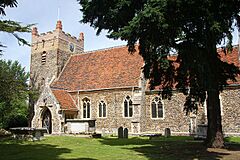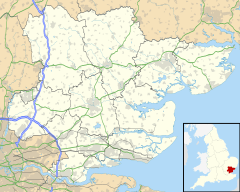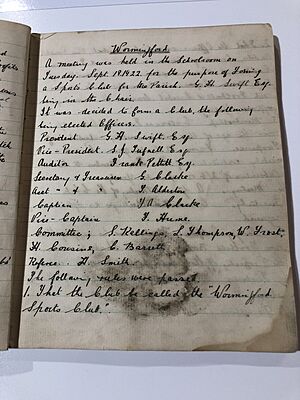Wormingford facts for kids
Quick facts for kids Wormingford |
|
|---|---|
 St Andrew's Church, Wormingford |
|
| Population | 454 (2011) |
| OS grid reference | TL938325 |
| Civil parish |
|
| District |
|
| Shire county | |
| Region | |
| Country | England |
| Sovereign state | United Kingdom |
| Post town | COLCHESTER |
| Postcode district | CO6 |
| Dialling code | 01787 |
| Police | Essex |
| Fire | Essex |
| Ambulance | East of England |
| EU Parliament | East of England |
| UK Parliament |
|
Wormingford is a small village in Essex, England. It is located in the City of Colchester area.
The village is found on the south bank of the River Stour. It is about 6 miles (10 km) north-west of Colchester. It is also about 8 miles (13 km) south-east of Sudbury in Suffolk. Wormingford covers an area of about 2,322 acres (929 hectares). The River Stour forms its northern border.
Wormingford has a post office and a pub. The pub is called The Crown and also has a restaurant.
Contents
About Wormingford's Land
Most of Wormingford is on a high plain. This land slopes down to the River Stour in the north. It also slopes down to the River Colne in the south. Near the Stour, the ground is low. It then rises to over 225 feet (70 meters) in the south-west.
The soil changes as the land rises. Near the river, there is soft river soil. Higher up, there are layers of clay, sand, and gravel. The highest parts of the parish have a type of clay called boulder clay. This soil is very good for farming.
The main road from Colchester to Bures and Sudbury (B1508) runs through the village. Smaller roads connect Wormingford to nearby places. These include Assington (Suffolk), Fordham, Little Horkesley, and Nayland (Suffolk). There are also many footpaths linking farms and houses.
The Village's Name and Legends
The name Wormingford comes from an old word. It originally meant 'Withermund's ford'. A ford is a shallow place in a river where you can cross. This ford was likely in the River Stour, near the watermill. Today, there is a sand bank there.
The ford was replaced by a bridge before 1802. This first bridge was for horses. Around 1821, a new, narrow wooden bridge was built. It fell down in 1895 or 1896. An iron bridge replaced it in 1898.
The modern name, Wormingford, appeared around 1254. This name led to three exciting stories about dragons! In old English, 'worm' could mean a serpent or dragon.
- The first story says that St George, England's patron saint, killed his dragon here. People say a mound in the village covers the dragon's body.
- The second story is about a crocodile. It supposedly escaped from Richard I of England's animal collection in the Tower of London. This crocodile caused a lot of trouble in Wormingford. Sir George Marney then killed it. A stained-glass window in St Andrew's Church shows this legend.
- The third story was written in 1405 by a monk named John de Trokelowe. It tells of a dragon that threatened Richard Waldegrave's land near Sudbury. But when chased, the dragon ran away into a lake.
Ancient History of Wormingford
Many old tools and objects have been found in Wormingford. These finds are from all periods, starting from the Stone Age. This suggests that people first settled near the River Stour. Over time, they cleared the forests on higher ground.
Near a lake in the north-west of the village, prehistoric tools were found. These were near old circular marks in the ground. In 1836, a Bronze Age burial mound was destroyed nearby. Hundreds of pots were found in rows inside it.
Famous Artists and Writers
The famous artist John Constable (1776–1837) had connections to Wormingford. His family farmed at Wormingford Hall.
Another artist, John Nash, lived in the village. He lived at Bottengoms, an old Elizabethan house. He painted scenes in and around Wormingford from 1929 until 1977.
The author Ronald Blythe later lived at Bottengoms. He inherited the house from John Nash. Blythe wrote a regular column called "Word from Wormingford" for the Church Times newspaper. He wrote it from 1993 to 2017.
Wormingford Mere
Wormingford Mere is a natural lake next to the River Stour. It covers an area of about 49,000 square meters (12 acres). This lake is very old, about 12,000 years old! It is a special type of lake called a kettle hole.
In 1981, a study by the University of Cambridge looked at the mere. They found the water is 6 meters (20 feet) deep. Below the water, there is 14 meters (46 feet) of mud. Scientists looked at a small piece of mud from the bottom. They found 9,000-year-old pollen. This pollen showed that the area used to have many hazel and birch trees.
The Colchester Archaeological Group thinks the mere is special. They believe it might have been used for ceremonies long ago. Perhaps people saw it as a way to connect with a "spirit underworld."
Wormingford Airfield's History
The Wormingford Airfield has a long history. It started as a small airfield for biplanes during the First World War.
It was made much bigger in 1942 and 1943. It was planned for a heavy bomber group. But this did not happen. In November 1943, the airfield was given to the Ninth Air Force. They used it for fighter planes.
The 362nd Fighter Group arrived at Wormingford on November 30, 1943. They flew their first mission on February 8, 1944. They only stayed a short time, leaving on April 8, 1944. While they were there, the 362nd flew over 30 missions. They lost five aircraft during this time.
Next, the 55th Fighter Group moved in. They flew P-38 Lightning planes. Their main job as a fighter group was short-lived. However, the 55th became famous for attacking targets on the ground. On D-Day, the P-38 groups helped by protecting the ships going to and from Normandy.
In July 1945, the 55th group left Wormingford. They went to Germany to help with the occupation forces. Today, the old airfield is used by the Essex and Suffolk Gliding Club.
Wormingford Sports Clubs
Wormingford has a local football team called Wormingford Wanderers. People often call them ‘The Worms’. They are an amateur football club. The main team plays in Division 1 of the Essex and Suffolk Border League. The reserve team plays in Division 4.
The club started in 1922. They play their games on the Wormingford playing fields, off Robletts Way.
The village also had a cricket club for many years. Sadly, the team no longer exists. It used to play in the PDQ North division. The team joined this league in 1976 and again in 1991.



